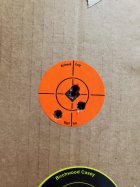PBking51
Gold $$ Contributor
I am new to the neck sizing game with my 300 wsm. This is for a hunting set up in a CA ridgeline, so I am using a forster bump /neck bushing die and Norma Brass. The only bushing I have for it is .333 at the moment. I am bumping the shoulder .002 back.
A 1x fired case from that gun has a neck is measuring .340
The one method says subtract .002 from a fired neck diameter and that's about the size bushing I need.
The other method has me measuring neck wall thickness x2 + .308 for the bullet and subtract .002 . Neck wall thickness is .015.
This indicates a .338 in method 1 and .336 in method #2.
Being that all I have on hand is a .333 what can I expect using this bushing? Will I just have to trim brass more frequently by technically over sizing the neck ? Or is there a degree of accuracy lost by doing this by having increased neck tension? Would I be better suited by purchasing a 338 and 337 bushing?
A 1x fired case from that gun has a neck is measuring .340
The one method says subtract .002 from a fired neck diameter and that's about the size bushing I need.
The other method has me measuring neck wall thickness x2 + .308 for the bullet and subtract .002 . Neck wall thickness is .015.
This indicates a .338 in method 1 and .336 in method #2.
Being that all I have on hand is a .333 what can I expect using this bushing? Will I just have to trim brass more frequently by technically over sizing the neck ? Or is there a degree of accuracy lost by doing this by having increased neck tension? Would I be better suited by purchasing a 338 and 337 bushing?











